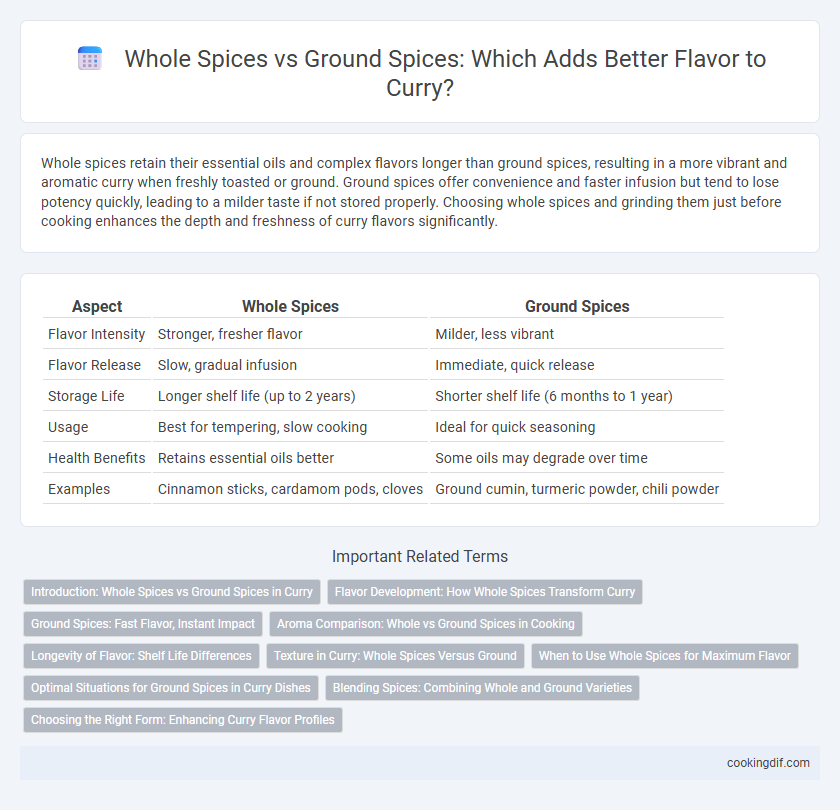Whole spices retain their essential oils and complex flavors longer than ground spices, resulting in a more vibrant and aromatic curry when freshly toasted or ground. Ground spices offer convenience and faster infusion but tend to lose potency quickly, leading to a milder taste if not stored properly. Choosing whole spices and grinding them just before cooking enhances the depth and freshness of curry flavors significantly.
Table of Comparison
| Aspect | Whole Spices | Ground Spices |
|---|---|---|
| Flavor Intensity | Stronger, fresher flavor | Milder, less vibrant |
| Flavor Release | Slow, gradual infusion | Immediate, quick release |
| Storage Life | Longer shelf life (up to 2 years) | Shorter shelf life (6 months to 1 year) |
| Usage | Best for tempering, slow cooking | Ideal for quick seasoning |
| Health Benefits | Retains essential oils better | Some oils may degrade over time |
| Examples | Cinnamon sticks, cardamom pods, cloves | Ground cumin, turmeric powder, chili powder |
Introduction: Whole Spices vs Ground Spices in Curry
Whole spices in curry offer a more intense and complex flavor profile as they release essential oils slowly during cooking, enhancing aroma and taste. Ground spices provide convenience and immediate flavor, blending seamlessly into curry but may lose potency faster due to exposure to air. Selecting between whole and ground spices depends on cooking time, desired flavor depth, and recipe authenticity.
Flavor Development: How Whole Spices Transform Curry
Whole spices release essential oils gradually during cooking, intensifying the flavor profile of curry with richer and more complex aromas compared to ground spices. Toasting whole spices before grinding enhances their depth, providing a fresher, more vibrant taste that cooks evenly throughout the dish. Ground spices, while convenient, tend to lose potency quickly and can result in a flatter, less dynamic flavor in curry preparations.
Ground Spices: Fast Flavor, Instant Impact
Ground spices provide fast flavor and instant impact in curry dishes due to their fine texture, which releases essential oils quickly when heated. Unlike whole spices that require longer cooking to unlock aroma, ground spices dissolve readily, enhancing flavor intensity within minutes. This rapid infusion makes them ideal for recipes needing immediate spice depth and balanced seasoning.
Aroma Comparison: Whole vs Ground Spices in Cooking
Whole spices retain their essential oils and volatile compounds longer, resulting in a more intense and fresher aroma when freshly toasted or ground before use in curry dishes. Ground spices release aroma compounds quickly but lose potency faster due to increased exposure to air and light, often leading to a milder fragrance in cooked dishes. Using whole spices at the beginning of cooking enhances the curry's depth of flavor through gradual oil extraction, while ground spices provide immediate but less complex aromatic impact.
Longevity of Flavor: Shelf Life Differences
Whole spices retain their essential oils and complex flavors longer than ground spices, which tend to lose potency quickly due to increased surface area exposure to air. The shelf life of whole spices ranges from four to five years, whereas ground spices typically maintain optimal flavor for only six months to two years. Storing whole spices in airtight containers away from heat and light further extends their longevity, preserving the vibrant taste essential for authentic curry dishes.
Texture in Curry: Whole Spices Versus Ground
Whole spices in curry deliver bursts of intense flavor and a noticeable texture contrast, enhancing the sensory experience with occasional crunch and aromatic pockets. Ground spices integrate seamlessly, providing consistent heat and depth without altering the curry's smooth texture. Selecting between whole and ground spices depends on the desired mouthfeel, with whole spices favored for layered complexity and ground spices preferred for uniform flavor distribution.
When to Use Whole Spices for Maximum Flavor
Whole spices release their oils slowly, offering a deeper, more complex flavor ideal for long-cooking dishes like stews and curries. Toasting whole spices before grinding or adding them whole to hot oil intensifies their aroma and enhances the overall taste profile. Use whole spices at the beginning of cooking to maximize flavor extraction and ensure a balanced, rich curry experience.
Optimal Situations for Ground Spices in Curry Dishes
Ground spices in curry dishes release flavors more quickly and evenly, making them ideal for recipes requiring short cooking times or quick flavor infusion. They are optimal for marinades, sauces, and dishes where a smooth texture is desired, enhancing the overall taste complexity without the grittiness of whole spices. Using ground spices also allows for precise measurement and consistent seasoning levels, crucial for balancing intense spices like turmeric, cumin, and coriander in curry preparations.
Blending Spices: Combining Whole and Ground Varieties
Blending whole and ground spices enhances curry flavor by balancing texture and aroma, as whole spices release essential oils slowly during cooking, while ground spices provide immediate, intense taste. Whole spices like cinnamon sticks, cardamom pods, and cloves add depth and complexity when toasted or fried, while ground turmeric, cumin, and coriander distribute flavor evenly throughout the dish. This combination creates layered seasoning, optimizing both freshness and warmth in curry recipes.
Choosing the Right Form: Enhancing Curry Flavor Profiles
Whole spices retain essential oils and release flavors gradually during cooking, making them ideal for slow-simmered curries that benefit from deep, layered aromas. Ground spices offer immediate, intense flavor, perfect for quick dishes or when a uniform spice blend is needed without texture interference. Selecting the right spice form depends on cooking time and desired flavor intensity to maximize the curry's aromatic complexity.
Whole spices vs Ground spices for flavor Infographic

 cookingdif.com
cookingdif.com